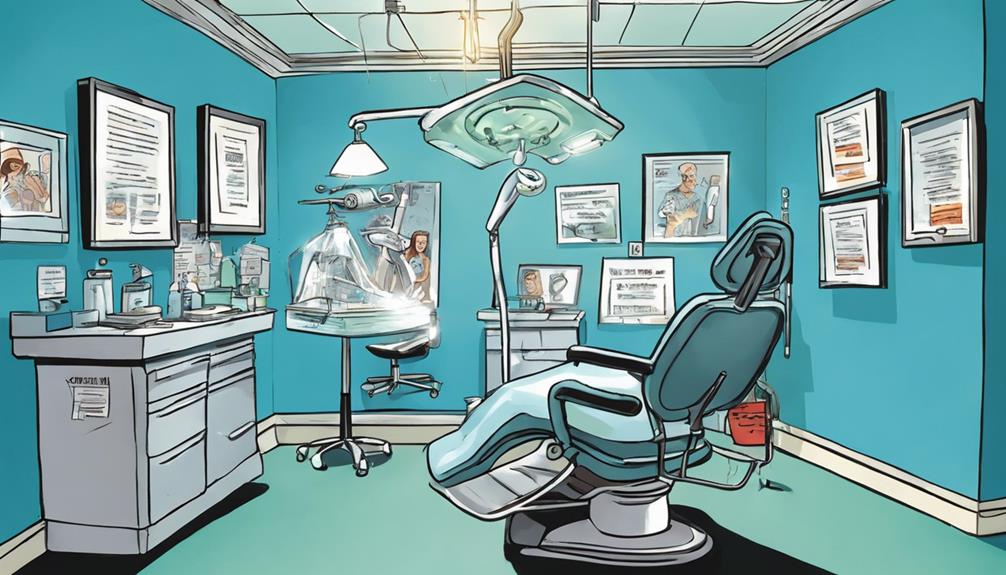During their teething phase, puppies lose all 28 baby teeth between six to eight months. You'll notice they start with their baby incisors, which fall out between 2 to 5 months. Next are the canines, lost around 3 to 5 months, followed by the premolars, which go between 4 to 6 months. As your puppy grows, watch for signs of discomfort like excessive chewing or drooling. By the time they reach eight months, they should have their complete set of 42 adult teeth. Want to know how to care for your teething pup?
Key Takeaways
- Puppies lose baby incisors first, typically between 2-5 months of age.
- Canine teeth follow, usually lost from 3-5 months.
- Premolars are lost between 4-6 months, with increased discomfort during this period.
- All baby teeth should be lost by 6-8 months, making way for adult teeth.
Puppy Teething Timeline
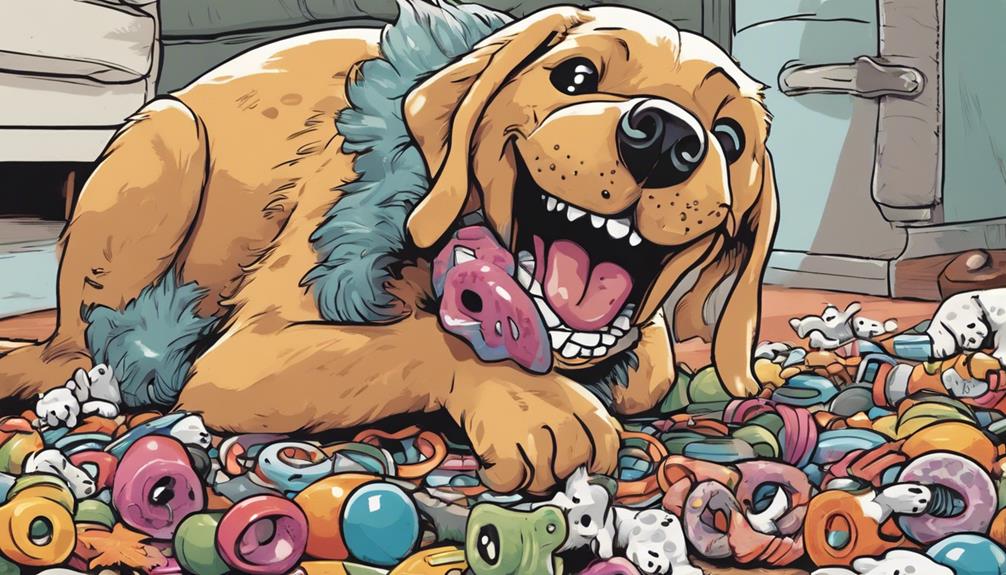
During the puppy teething timeline, you'll notice your furry friend losing their baby teeth, starting with the incisors between 2 and 5 months of age. This initial phase is vital as puppies lose their baby incisors, which are small, sharp, and important for their chewing habits.
As your puppy approaches the 3 to 5-month mark, you'll see the canine teeth follow suit, making way for the growing permanent adult teeth.
Between 4 and 6 months, the teething process continues with the loss of premolars. This period can be quite challenging for both you and your puppy, as they might experience discomfort and increased chewing behavior.
It's important to provide appropriate chew toys during this time to help soothe their gums.
Types of Puppy Teeth
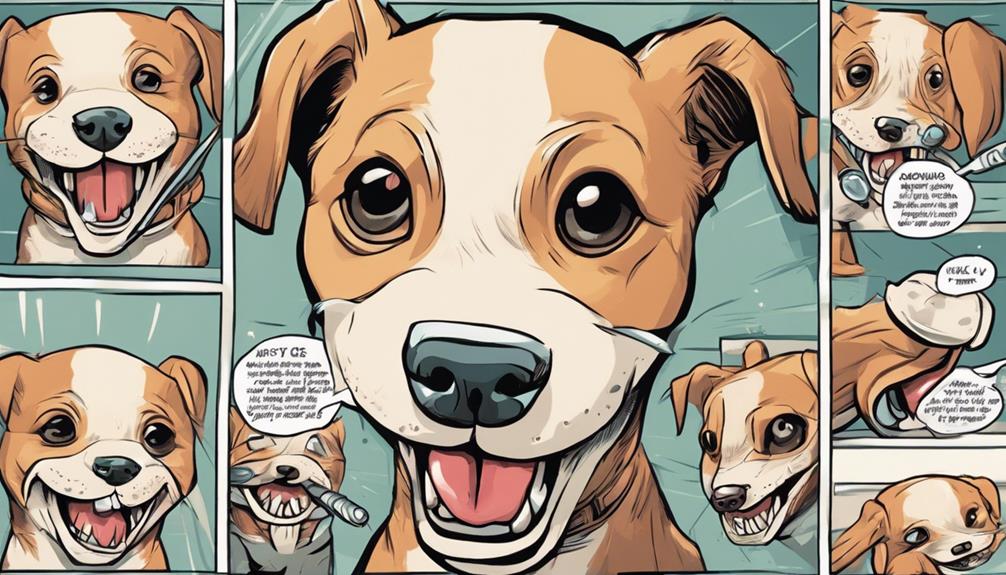
Puppies have four main types of teeth: incisors, canines, premolars, and molars, each serving a specific purpose in their development and chewing habits. Understanding these types can help you care for your puppy's dental health as they grow.
Incisors: These tiny teeth are used for nibbling and grooming. Puppies have 12 baby incisors, and they're usually the first to be lost around 2-5 months.
Canines: The pointy canines, known as fangs, help in grasping and tearing food. Puppies have 4 of these, which are typically lost between 3-5 months.
Premolars: Essential for grinding food, puppies have 12 premolars that are lost between 4-6 months as they make way for adult teeth.
Molars: While puppies don't have baby molars, they'll eventually grow into 10 adult molars.
Adult Teeth: By 6-8 months, all baby teeth are lost, replaced by a total of 42 permanent teeth.
Knowing the types of puppy teeth can help you track their dental changes and guarantee they stay healthy as they progress to adult teeth.
Order of Tooth Loss

The order of tooth loss in puppies follows a specific sequence, starting with the baby incisors. Typically, puppies lose their teeth in a predictable manner as they shift from their baby teeth to permanent teeth. This process usually begins around 3.5 months and can last until they're about 6 to 8 months old.
Here's a quick breakdown of the order of tooth loss:
| Stage | Age Range (Months) |
|---|---|
| Baby Incisors | 2 – 5 |
| Canine Teeth | 3 – 5 |
| Premolars | 4 – 6 |
| All Baby Teeth | 6 – 8 |
| Adult Teeth Erupted | By 8 |
As a teething puppy, you might notice that the baby teeth fall out as the adult teeth begin to erupt. First, the baby incisors go, followed by the canine teeth. Premolars are next, as they are replaced by adult molars. By the time your puppy reaches 8 months old, all 28 of their baby teeth have fallen out, and they should have all 42 permanent teeth.
Signs of Teething
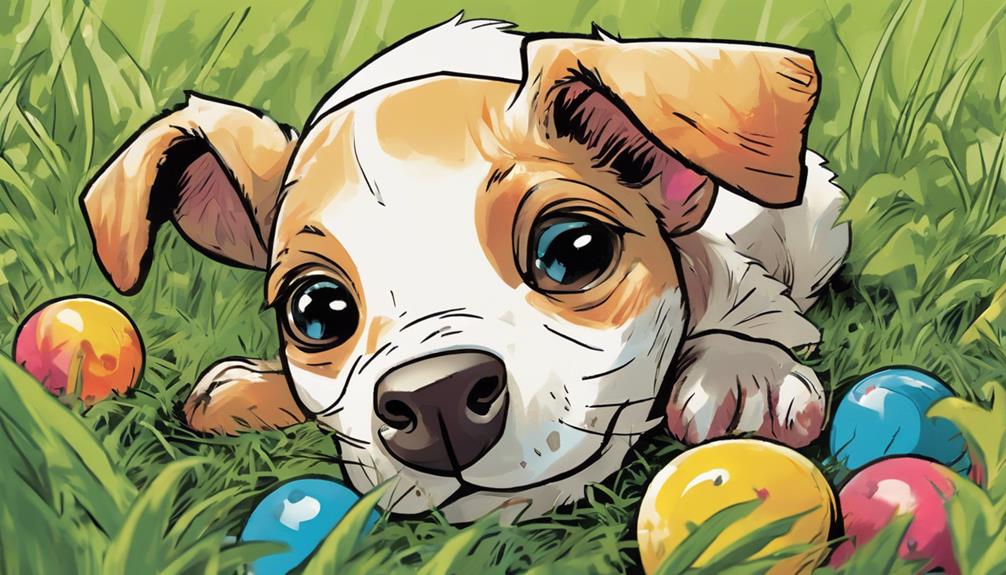
As your puppy loses their baby teeth, you'll likely notice several signs that indicate they're teething and experiencing discomfort. Teething can be a challenging time for both you and your pup, but recognizing the signs can help you provide better support.
Here are some common signs of teething:
- Increased chewing behavior: Your puppy may chew on anything they can find, including furniture and shoes.
- Drooling: Excessive drooling is a common symptom, as their gums may be sore and inflamed.
- Discomfort: You might notice your puppy whining, pawing at their mouth, or appearing restless.
- Small blood spots: Look out for small blood spots on their teething toys, which can indicate the loss of puppy teeth.
Providing appropriate teething toys can help alleviate some discomfort and redirect their chewing behavior.
Caring for Teething Puppies

Caring for teething puppies requires you to provide safe chewing options that soothe their sore gums.
Consider using frozen chew toys and soft rubber items to alleviate their discomfort.
Don't forget to monitor their chewing habits and offer plenty of cuddles to help them feel secure during this tough time.
Safe Chewing Options
Providing safe chewing options is essential for soothing your teething puppy's discomfort while keeping them engaged and happy.
Choosing the right toys and treats can aid in their dental care and help with the shift from baby teeth to adult teeth. Here are some safe and healthy chewing options to evaluate:
- Soft rubber toys: These provide gentle relief for sore gums.
- Dental rings: Designed to promote healthy teeth while satisfying chewing urges.
- Frozen toys: Chilled rubber toys can help numb discomfort.
- Chilled fruits and veggies: Blueberries, green beans, or carrots can serve as tasty, teething-friendly treats.
Always remember to supervise your puppy while they chew to guarantee they don't accidentally swallow harmful parts or choke on toys.
Avoid hard objects like bones or nylon toys, as these can break baby teeth and cause dental injuries.
Comforting Teething Techniques
Regularly using comforting techniques can greatly ease your teething puppy's discomfort and help them feel more secure.
One effective way to soothe your puppy during this challenging time is by providing a variety of safe chew toys, like soft rubber or dental rings. These toys not only help alleviate teething issues but also redirect their chewing behavior away from your belongings.
For added relief, consider offering frozen chew toys or chilled items that can numb sore gums. Regular cuddles and gentle handling can also comfort your teething puppy, reducing both anxiety and discomfort.
Pay close attention to their chewing habits; if they start chewing on inappropriate items, gently redirect them to their designated chew toys.
If you notice severe teething issues, such as persistent pain or a reluctance to eat, it's essential to consult your veterinarian. They can provide tailored advice and potential interventions to guarantee your puppy stays healthy and happy during this phase.
Safe Teething Toys

When it comes to safe teething toys, you want to choose durable options that won't break apart easily.
Frozen toys can be a game changer, soothing your puppy's sore gums while keeping them entertained.
Remember to supervise their chewing to guarantee they stay safe and happy during this phase.
Types of Safe Toys
Choosing safe teething toys is essential for puppies to help redirect their natural chewing instincts and protect your belongings from damage. By providing appropriate toys, you can make the teething process more comfortable for your furry friend.
Here are some great options:
- Soft rubber toys: Gentle on gums and perfect for chewing.
- Dental rings: Designed to promote dental health while your puppy chews.
- Frozen chew toys: Soothe sore gums and provide relief.
- Rope toys: Great for tugging and chewing, and they can help clean teeth.
It's vital to monitor wear and tear on these toys regularly. As your puppy chews on them, they may wear down, posing a potential choking hazard.
Rotating different types of teething toys not only keeps your puppy engaged but also prevents boredom. By choosing the right teething toys, you can support your puppy's dental health while keeping your home safe from destructive chewing.
Benefits of Frozen Toys
Frozen toys offer soothing relief for teething puppies, effectively numbing sore gums and reducing inflammation during this uncomfortable phase. When your puppy's teeth start to come in, the discomfort can lead to excessive chewing. Frozen chew toys provide a cold, appealing alternative that helps distract your puppy from inappropriate items around the house.
Opt for frozen rubber toys and dental rings, as they're designed to withstand even the most aggressive chewers while offering comfort. The cold temperature encourages your puppy to chew, which aids in the natural process of losing baby teeth and the emergence of adult teeth. By providing these frozen toys, you not only soothe their teething pain but also promote healthy chewing habits.
Healthy chewing habits can prevent destructive behaviors, making the teething process smoother for both you and your puppy. These frozen toys are more than just a distraction; they play a critical role in helping your puppy navigate this challenging time.
Monitoring Chewing Safety
Monitoring your puppy's chewing safety is vital to guarantee they use only appropriate teething toys that won't harm their health or your belongings.
With teething puppies, choosing the right chew toys can make a significant difference in their comfort and your peace of mind. Here are some safe options to take into account:
- Soft rubber toys: Gentle on sore gums while providing a satisfying chew.
- Dental rings: Specifically designed to promote oral health and ease teething discomfort.
- Frozen chew toys: Ideal for soothing sore gums and providing relief.
- Flexible toys: Less likely to cause dental damage compared to hard objects.
While your puppy is chewing, it's important to supervise them closely. This way, you can prevent any accidents, like ingesting unsafe items or choking.
Always avoid hard objects, such as bones or nylon toys, which can break their teeth.
Dental Health Concerns

During the teething phase, you should be alert for dental health concerns that can arise in puppies, such as retained baby teeth or signs of discomfort.
As baby teeth start to fall out, puppies develop adult molars, which can sometimes lead to complications if the baby teeth don't fully shed. Retained deciduous teeth can cause misalignment, known as malocclusion, and contribute to dental disease, particularly in smaller breeds.
Watch for signs like bad breath, trouble eating, or excessive drooling, as these can indicate potential dental issues. If not addressed, these problems may escalate into more severe conditions, such as periodontal disease, which affects the gums and supporting structures of the teeth.
Regular veterinary check-ups during this critical period are vital to monitor your puppy's dental health. Your vet can help identify any retained teeth or other issues before they become serious problems.
Normal Vs. Abnormal Teething
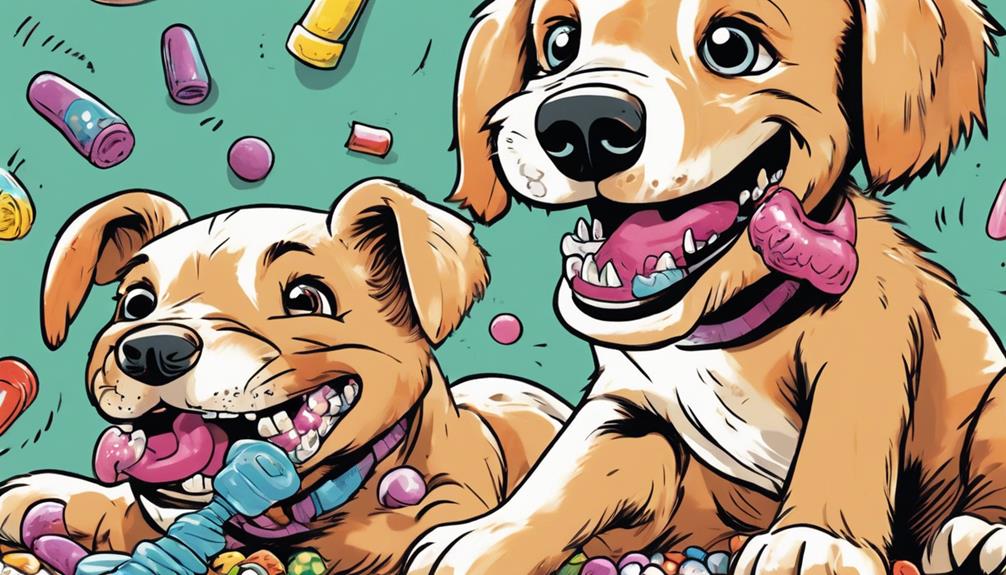
When your puppy starts teething, it's important to know what to expect during this typical timeline.
You should watch for signs of abnormality, like excessive drooling or pain, that could indicate something isn't right.
Recognizing these differences early on can help guarantee your pup stays healthy and comfortable.
Typical Teething Timeline
Understanding the typical teething timeline is essential, as it helps you distinguish between normal and abnormal teething in puppies.
Typically, puppies start getting their baby teeth at around 3.5 to 4 months of age. Here's what you can expect during this period:
- Puppies lose their first baby teeth, the incisors, between 2 to 5 months.
- Canine teeth usually follow, being lost between 3 to 5 months.
- Premolars are typically lost between 4 to 6 months.
- By six months old, puppies should have a full set of 42 permanent teeth.
Most puppies will have lost all 28 baby teeth by the time they're six months old.
If your puppy hasn't lost their first baby teeth or shows signs of persistent teething issues beyond eight months, it's a good idea to schedule an appointment with your veterinarian.
Keeping an eye on this timeline will help guarantee your furry friend develops healthy teeth as they shift to their permanent set.
Signs of Abnormality
Recognizing the signs of abnormal teething in your puppy is vital for guaranteeing their dental health and overall comfort. As your puppy's teeth begin to fall, you should monitor their behavior closely. While some drooling is normal, excessive drooling can indicate discomfort or pain. Additionally, if your puppy refuses to eat, it could be a sign of abnormal teething that requires your attention.
Puppies typically follow a teething timeline where they lose their baby teeth in a predictable order. However, if your puppy retains baby teeth beyond six months, complications like misalignment of adult teeth or periodontal disease may arise. Look for warning signs such as blood spots on toys, persistent whining, or pawing at the mouth. These can signal potential issues with their teething process.
If you notice any of these signs of abnormal teething, it's important to consult your veterinarian. Early intervention can prevent long-term dental problems and secure your puppy's overall health. Remember, understanding the difference between normal and abnormal teething can make a significant difference in your puppy's comfort and well-being.
Monitoring the Teething Process

Keep a close eye on your puppy's mouth during the teething process to catch any signs of discomfort or potential issues.
As your puppy begins losing their baby teeth, monitoring is essential. Here are some key aspects to observe:
- Timing: Puppies usually start losing their puppy teeth around 3.5 months.
- Sequence: Incisors typically fall out first, followed by canines and premolars.
- Retention: Watch for any retained baby teeth, which can lead to dental complications.
- Discomfort: Look for signs of pain or discomfort, like excessive drooling or chewing.
Keeping track of these factors will help guarantee your puppy's teething process goes smoothly.
If you notice any abnormalities, such as retained baby teeth or prolonged discomfort, it's important to address these issues promptly.
Properly monitoring your puppy's dental health now can prevent complications later on, ensuring their permanent teeth come in healthy and strong.
When to Consult a Veterinarian

If your puppy's baby teeth haven't started falling out by 4-5 months, it's important to consult a veterinarian, as this may signal retained deciduous teeth. Retained teeth can lead to overcrowding and dental issues, making timely action significant.
During the teething process, you should monitor your puppy for signs of severe discomfort or pain. If your puppy seems reluctant to eat or play, it's a good idea to consult a veterinarian. Additionally, keep an eye out for unusual swelling, bleeding, or signs of infection around the mouth. These symptoms may indicate a need for immediate veterinary attention.
If your puppy has loose teeth that don't naturally fall out or appear stuck, don't hesitate to consult a veterinarian. This can help avoid complications like misalignment or infections.
Regular veterinary check-ups during the teething phase are also important. They allow for proper dental development and help identify potential issues early on. By staying proactive and attentive, you can guarantee that your puppy's dental health remains on track as they shift from baby teeth to adult teeth.
Frequently Asked Questions
In What Order Do Puppies Lose Their Teeth?
You'll notice puppies lose their baby incisors first, usually between 2-5 months. Next, they shed baby canines around 3-5 months, followed by premolars between 4-6 months, making way for their adult teeth.
How Do You Know When a Puppies Teeth Are About to Fall Out?
When your puppy's teeth begin their graceful exit, you'll notice them chewing more, drooling, and possibly feeling a bit off. Look for loose teeth or tiny blood spots as clues they're ready to go.
Do 4 Month Old Puppies Lose Their Teeth?
Yes, 4-month-old puppies do lose their teeth. You'll notice increased chewing and some discomfort as they begin shedding baby teeth. This process typically starts with incisors and continues with canines as adult teeth emerge.
What Are the Worst Weeks for Puppy Teething?
When your puppy's teeth start falling out, expect the worst weeks to hit between 12-16 weeks. You'll notice increased chewing and discomfort, so make sure you've got plenty of soothing chew toys handy.
Do Puppies and Babies Lose the Same Baby Teeth?
Yes, puppies and babies both lose their baby teeth, following a similar process. This baby teeth lost guide is helpful for pet owners and parents alike, as it explains the timeline and process of their little ones losing their baby teeth. It’s a natural part of development for both puppies and babies. Understanding the puppy teething timeline can help pet owners know what to expect and how to help their furry friends through this process. Just like with babies, puppies may experience discomfort and a strong urge to chew during this time. Providing appropriate teething toys and keeping an eye on their oral health can help make the transition smoother for both puppies and their owners.
Conclusion
To sum up, your puppy's teething journey is a whirlwind of tiny teeth falling out and new ones coming in, like a miniature tornado of dental change!
By understanding which baby teeth they lose and how to care for them, you can make this process smoother.
Keep an eye out for signs of discomfort, and don't hesitate to consult your vet if something feels off.
With your support, your pup will soon have a dazzling adult smile that'll light up the room!

